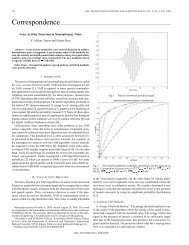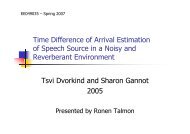Thesis (PDF) - Signal & Image Processing Lab
Thesis (PDF) - Signal & Image Processing Lab
Thesis (PDF) - Signal & Image Processing Lab
Create successful ePaper yourself
Turn your PDF publications into a flip-book with our unique Google optimized e-Paper software.
the number of gray levels is high, or if the image is very complex, the BTV transform<br />
usually fails. The reason for that is the existence of skeleton (watershed) points<br />
in the BTV data, which have neighbors with potentially very dissimilar alternating<br />
sequences; when eroded, a “trench” may open at these points, because the infimum<br />
of the dissimilar alternating sequences yields a sequence that does not characterize<br />
any of the neighbors. Although some of the “trenches” disappear, when we perform<br />
opening instead of erosion, the results are still not good, see Fig. 4.4.<br />
Let us consider a one dimentional example, given in Table 2.1, in order to under-<br />
stand the origin of the trenches. In this example, x = 5 is a skeleton (or watershed)<br />
point of the BTV transform of function f(x), with two different transform possibil-<br />
ities {−2, 13, −1} and {8, −3, 5}. For x = 4 the alternating sequence is {−2, 13}.<br />
Therefore, the infimum between two neighbors {−2, 13} and {8, −3, 5} is {0}. This<br />
produce the trench at x = 4.<br />
Fig. 4.5 shows the output of the erosion ˆεB on the one dimentional function f(x).<br />
Figure 4.5: Results of BTV-based erosion ˆεB. (a) Function f(x), and (b) Erosion of<br />
f(x).<br />
Solutions for the “trench” problem are proposed in the following sub-sections.<br />
47
















